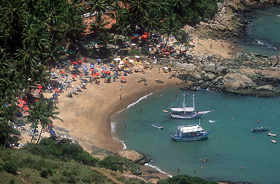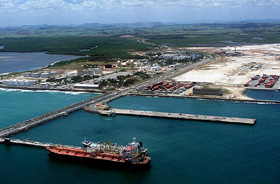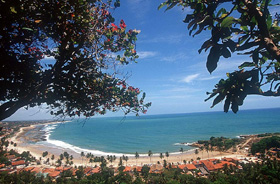Facts
Culture
Travel
Beaches
Porto de Galinhas
Hotels
Restaurants
World Cup
Olinda
Pernambuco
|
Cabo de Santo Agostinho - Pernambuco
«Recife
« Cities of Pernambuco
Population: 152.977 inhabitants
Area: 448 km2
Distance from Recife: 41 km
Accesses: BR-101 Sul e PE-07 (both duplicated, till the Cabo). Visit maps of Recife and Pernambuco.
History
 The name means Cape of Saint Augustine.
The name means Cape of Saint Augustine.
The city of Cabo de Santo Agostinho is distant 41 km from Recife and is place of the biggest industrial pole of Pernambuco and of a wonderful scenery of beatiful beaches.
There is a controversial theory which says that the region of Cabo was the place where Brazil was discovered.
Some History researchers say that before Pedro Álvares Cabral arrived in Bahia on April 21st 1500 (official date of discovering of Brazil), Vicente Pinzon had already moored in the bacia de Suape, on January 26 of 1500, and named it as Cabo de Santa Maria de La Consolación.
In the schools maintained by the city of Cabo, this is the version taught to the children as being the official discovering of Brazil.
Economy
The city of the Cabo de Santo Agostinho is the biggest industrial cluster of Pernambuco.
An industrial complex was built around the Port of Suape, taking advantage of the Port itself and the infrastructure of roads and (still limited) railways which connect the port to Recife and other important cities; besides, both the governments of the State of Pernambuco and the city of Cabo have been offering tax incentives for new enterprises to establish in the area.
Currently, there are over 50 large sized enterprises around the Suape cluster, providing 4,000 direct jobs and an estimated 20,000 indirect jobs.
Recently (2005), the Federal government announced that a new oil refinery will be built in Ipojuca, near Suape; the massive investment of US$ 2 bn was disputed by several States in the Northeast of Brazil, and the main advantage of Ipojuca was, again, the proximity with Suape. Update: in 2013, the refinery was not ready yet, and costs were re-estimated to US$ 14 bn.
 The tourism is also an important sector of the economy. A growing infrastructure of hotels, restaurants and other tourist services have been developed over the past years, to attend visitors attracted by the beaches in the south coast of Pernambuco.
The tourism is also an important sector of the economy. A growing infrastructure of hotels, restaurants and other tourist services have been developed over the past years, to attend visitors attracted by the beaches in the south coast of Pernambuco.
The city of Cabo is responsible for maintaing the Barragem de Pirapama (Pirapama Dam), which supplies water to the Metropolitan Region of Recife (MRR), reaching approximately 1,3 million people. This is one of the largest water deposit in the State, with a capacity of 61 million cubic meters of water.
Cabo de Santo Agostinho is part of the Metropolitan Region of Recife (MRR), wich comprehends also the municipal districts of Recife, Olinda, Jaboatão dos Guararapes, Abreu e Lima, Paulista, Igarassu, Itapissuma, Itamaracá, Ipojuca, Camaragibe, São Lourenço da Mata, Araçoiaba and Moreno.
Tourism
Cabo de Santo Agostinho offers to visitors options of ecological reserves, mangroves and some of the most beautiful beaches in Pernambuco, such as the beaches of Calhetas, Paraíso and Gaibu (picture). These beaches attract people looking for tranquility as well as those looking for nautical sports.

Besides the beaches, the historical monuments also attract tourists to Cabo. Ancient sugar cane mills (in Portuguese called "engenhos") are still operating in the city, some open to visitations; special care is taken to preserve the History of such places.
Among the historical buildings, one can visit the Igreja de Nossa Senhora de Nazaré (Nossa Senhora de Nazaré Church) and the ruins of the convento carmelita (carmelita convent), wich dates back to late 16th century years, and the Forte Castelo do Mar (Sea Castle Fortress), built in 1631 by the Portuguese utilizing granite of the region, in an attempt to protect the area form the Dutch invasors.
Like many other cities in Pernambuco, Cabo has also a good number of handicrafters; in Cabo, there is a particular preference by pottery. Many pieces can be seen and bought at the Mercadão (Big Market), an excellent place to get in touch with the culture of northeastern Brazil.
During the Festas Juninas, the best way to reach Cabo is by boarding the Trem do Forró (Forro Train): seats are displaced to make room for people to dance, to the sounds of a few forro bands which play inside the wagons.
Information source: IBGE and Government of the State of Pernambuco
|
|